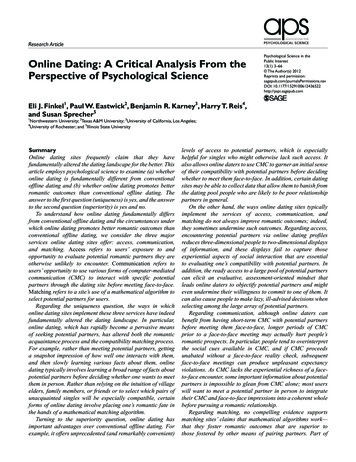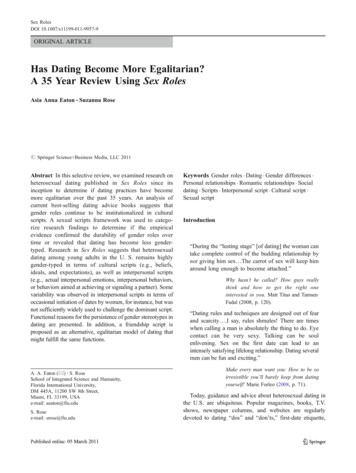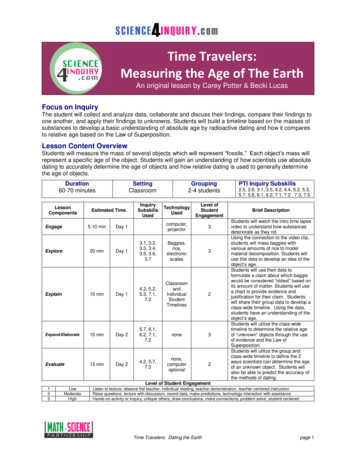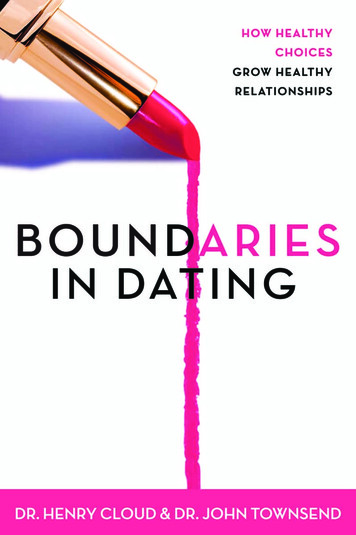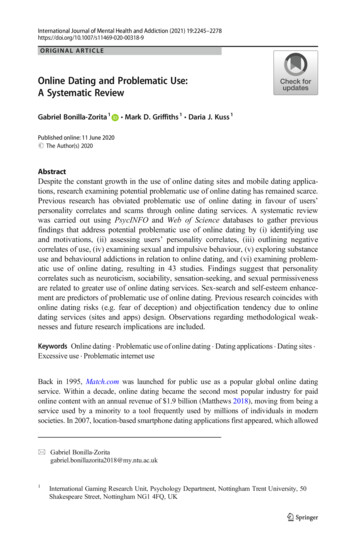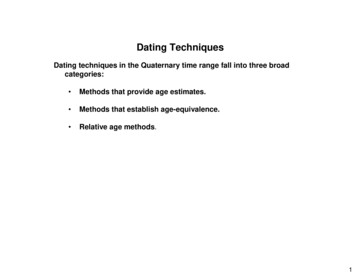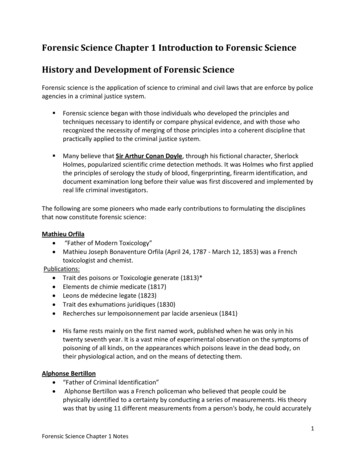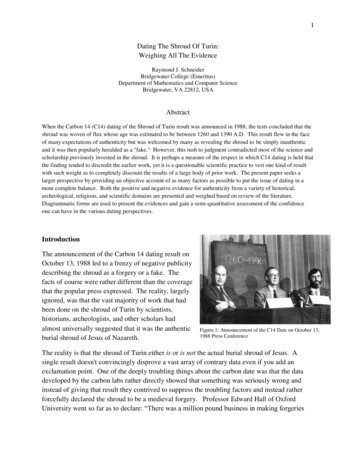
Transcription
1Dating The Shroud Of Turin:Weighing All The EvidenceRaymond J. SchneiderBridgewater College (Emeritus)Department of Mathematics and Computer ScienceBridgewater, VA 22812, USAAbstractWhen the Carbon 14 (C14) dating of the Shroud of Turin result was announced in 1988, the tests concluded that theshroud was woven of flax whose age was estimated to be between 1260 and 1390 A.D. This result flew in the faceof many expectations of authenticity but was welcomed by many as revealing the shroud to be simply inauthenticand it was then popularly heralded as a "fake." However, this rush to judgment contradicted most of the science andscholarship previously invested in the shroud. It is perhaps a measure of the respect in which C14 dating is held thatthe finding tended to discredit the earlier work, yet it is a questionable scientific practice to vest one kind of resultwith such weight as to completely discount the results of a large body of prior work. The present paper seeks alarger perspective by providing an objective account of as many factors as possible to put the issue of dating in amore complete balance. Both the positive and negative evidence for authenticity from a variety of historical,archeological, religious, and scientific domains are presented and weighed based on review of the literature.Diagrammatic forms are used to present the evidences and gain a semi-quantitative assessment of the confidenceone can have in the various dating perspectives.IntroductionThe announcement of the Carbon 14 dating result onOctober 13, 1988 led to a frenzy of negative publicitydescribing the shroud as a forgery or a fake. Thefacts of course were rather different than the coveragethat the popular press expressed. The reality, largelyignored, was that the vast majority of work that hadbeen done on the shroud of Turin by scientists,historians, archeologists, and other scholars hadalmost universally suggested that it was the authenticburial shroud of Jesus of Nazareth.Figure 1: Announcement of the C14 Date on October 13,1988 Press ConferenceThe reality is that the shroud of Turin either is or is not the actual burial shroud of Jesus. Asingle result doesn't convincingly disprove a vast array of contrary data even if you add anexclamation point. One of the deeply troubling things about the carbon date was that the datadeveloped by the carbon labs rather directly showed that something was seriously wrong andinstead of giving that result they contrived to suppress the troubling factors and instead ratherforcefully declared the shroud to be a medieval forgery. Professor Edward Hall of OxfordUniversity went so far as to declare: “There was a million pound business in making forgeries
2during the fourteenth century. Someone just got a bit of linen, faked it up and flogged it.” [1]The problem with this summary judgment is that the data set developed by the three carbon labsat Arizona, Oxford, and Zurich told a very different story from the one communicated by thecarbon labs. What the carbon labs should have announced was that their testing had revealedthat the samples they received were inhomogeneous and hence invalid for establishing the age ofthe shroud.The Flawed Carbon Dating ProcessThe problem with the samples did not originate with the carbon labs however. WilliamMeachum had warned in a submission to Archbishop Ballestrero: "It is a very serious errorindeed to proceed with C14 dating on the assumption that it is an infallible method." [2] Aprotocol had been recommended by the Turin conference held in September 1986. It wasadvanced as a recommendation and not a binding agreement. None the less therecommendations involved more than three labs, a mix of both counter labs and AMS(Accelerator Mass Spectrometry) labs, and most importantly samples from multiple sites. Thedecision to limit the dating to three labs, using only the AMS method and restricting thesampling to a single highly contaminated site were all outcomes determined by a politicized andhighly bureaucratic process of Byzantine proportions. Mix in a lot of backbiting and intrigue asthoroughly documented by Harry Gove [3] and William Meacham [4] and you have a recipe fordisaster.Problematical ResultsThings might have gone well despite these questionable decisions. A tight grouping of resultsfrom the three labs similar to their results on the control samples would have left little room fordisagreement whether the result had beenfavorable to authenticity or to medievalfabrication. But that was not the result.Figure 2: Table 2 Summary of mean radiocarbon dates and assessmentof interlaboratory scatter: https://www.shroud.com/nature.htmThe shroud (sample 1) exhibited ananomalously high χ² test of 6.4 comparedwith the control samples. This indicatedthat the shroud samples were nothomogeneous. But there are moresignificant data reduction findings whichas the carbon dating results have beenstudied suggest order in theinhomogeneity. Three images and twoanalyses are worthy of attention.
3Figure 3: The images above are respectively the Blue Quad Mosaic, the UV-Fluorescent, and a false color image where thefalse colors map the Principle Component Analysis intensity of the UV-Fluorescent image, an analysis performed by JohnMorgan. 1978 Barrie M. Schwortz Collection, STERA, Inc. , 1978 Vernon Miller, 2012 J.M. Morgan, IIIThe Blue Quad Mosaic image is a multispectral false color image which reflects the surfacechemical composition of the shroud. It rather clearly shows that the sample region just to theright of the Raes patch covering the sample taken in 1973 is different from the rest of the cloth.Although more subtle, the UV-Fluorescent image taken by Vern Miller is also darker in thatregion and this can be seen in both the UVFluorescent image as presented and in the falsecolor image resulting from John Morgan'sanalysis. These images establish the poorchoice of the region near the Raes sample andhad there been a significant study of the siteselection for the dating would likely not havebeen selected. But there wasn't.Figure 4: Linear Gradient observed by Brian Walsh [5]Brian Walsh [5] observed that there was alinear gradient in the Carbon 14 lab results asyou plotted the data from the edge of the shroud. This strongly suggests a systematic enrichmentmechanism that maps to locations on the shroud as measured from the edge. The coefficient ofdetermination, R2, computed to 0.4928 which means a correlation coefficient of 70.2%.John M. Morgan III did an analysis of the UV-Fluorescence image that produced surprisingresults. He began the analysis to illustrate the use of techniques used by the land remote sensingcommunity. What he discovered seems more significant than merely the illustration of thepotential application of some analysis methods. Notably he showed (although it is not in hispaper) that the fluorescence correlates almost perfectly with the carbon dates.
4When you compare the laboratorycarbon dates with the Z-Scoreresulting from a PrincipleComponent Analysis (PCA) of theUV-Fluorescence data you get acoefficient of determination of0.9986 which corresponds to acorrelation coefficient of 99.93% aextraordinarily high value given thatwhat it says is that the averageFigure 5: Nearly perfect correlation between average carbon dates and the UVFluorescence as measured by the PCA Z-score [6]carbon date is almost perfectlypredicted by the UV-Fluorescence.There is no reason to expect such a result obtained by putting data from the paper [6] into anExcel spread sheet. It suggests that fluorescence predicts carbon date. This amounts to an actualmeasure of contamination.At this point the conclusion is that the Carbon Dating of 1988 is not only unreliable but indeedcontains clues that point to systematic biasing factors related to position and fluorescence. Otherwork by Ray Rogers, John Brown, Sue Benford, Joe Marino, and more recently Pam Moon haverevealed the presence of anomalous cotton, dyes, potential invisible weaving and rogue threadsthat suggest manipulation. [7]The Journey to TruthThe carbon dating result of 1260-1390 with 95% probability either represents reality of it doesn't.We have many reasons to think that it is flawed but because carbon dating has such a reputationfor being authoritative, the dating takes on an appearance of infallibility. The reality is thaterroneous carbon dates are not a rare occurrence. Discovering the truth is fundamental tounderstanding. It is reasonable to ask a rather fundamental question: How do we know what istrue about the Shroud of Turin? Is the shroud the work of a medieval forger or is it the burialshroud of Jesus Christ? I hope to take you on a journey as you read this paper, a journey ofdiscovery with many mentors.Joseph Campbell wrote a book titled "The Hero with aThousand Faces." [8] We can liken the journey of discovery ofthe truth about the Turin shroud to the myth of the hero'sjourney which begins with a call to adventure and as we enterthe unknown we discover that we can't do it alone. We needhelp in the form of helpers and mentors. The shroud is at thecenter of our quest for the truth. Many have sought tounderstand it and the 1988 Carbon Date with all the questionsand doubts that it inspires appears at the nadir of our journey.
5The conviction that carbon dating was the last word seriously crippled shroud research andtransformation, if it is achieved, will not be an easy journey.The Primacy of StoryStories come in many forms and styles and follow many rules of composition and development.Everything men and women communicate is a story of one form or another. Some stories aremore convincing than others. Some are more formal than others. A science story is one set in arealm of observations and calculations and principles and is intended to confirm anunderstanding of reality. This is no less true of archeological stories, or history stories,eyewitness testimony, stories told through pictures in the form of art or photography, and storiesof religion about transcendent realities. Each kind of story follows the rules of its kind. Allstories are more or less well told, are more or less entertaining, but finally the test of story iswhether the story is true. Only true stories have real value for the rest are only lies.What is Truth?"What is truth?", Pontus Pilate asked Jesus Christ (John 18:38). Truth is the correspondencebetween story and reality. At least that's a short form of what Aristotle might have said. [9] It isunlikely that we can know the entire truth about anything but we can likely know enough todiscern the difference between truth and fabrication.How do you know the truth?To know what truth is, and to know ifsomething is actually true are rather differentproblems. Typically we determine ifsomething is true by applying various tests. Ioffer four: 1) Direct Observation, 2) CorrectInterpretation, 3) Correspondences with other known truths, and 4) Coherence or Fit.Direct ObservationDirect observation can be abbreviated as witness. There is no greater certainty available than tosee things for yourself. This experience might be parsed into two aspects: 1) the factual accountof what was observed, and 2) the interpretation of the observations. The first is an account ofobservables while the second is an interpretive inference based on existing principles orunderstandings. A remote account of witness is a report of testimony by a witness. This is lessauthoritative since the report imposes a non-witness into the information stream.
6Correct InterpretationThe interpretive dimension of witness has to be correct for that aspect to be authoritative. Ithelps to determine correctness by being as explicit as possible about the nature of theinterpretation.Correspondences with other known truthsAn observation is strengthened when it is corroborated by correspondences with otherobservations either repeated witness or reliability of interpretive principles through theirsuccessful application in other cases that bolster their applicability to the case at hand.Coherence or FitFinally when multiple observations form a self-validatingmosaic such that all the pieces fit together in a supportivefashion this strengthens the case. The metaphor of thepuzzle illustrated above is an example.[10]Weighing the EvidenceApplying these four indicators of truth we will strive to decide between the two possibilities thaton the one hand the shroud in the creation of a medieval forger or on the other hand it is mucholder than the 1988 Carbon Dating indicated and hence may well be the authentic burial shroudof Jesus Christ. It is not enough to consider only a single, possibly flawed, observation such asthe carbon dating. Richard Feynman, Nobel Prize winning physicist and celebrated physicseducator, makes the point when he says, "You see, if you don't have a good reason, you have tohave several reasons " [11] It is also worth considering a point Feynman makes elsewhere inwhich he points out how hazardous it is to rush to judgment. Ignorance is preferable to a falseanswer. Feynman says[12], "I would rather have questions that can't be answered than answersthat can't be questioned." Our goal then is to examine as much evidence as we can to weigh thealternatives.The Implausibility of the Forger HypothesisIf the shroud were actually medieval as the 1988 Carbon Data suggests then it would have tohave been fabricated sometime in the interval 1260 to 1390 A.D. which nicely brackets thetimeframe when it was first exhibited in Lirey, France about 1355. The problem with this as ahypothesis is that it requires a super forger. We'll spend a little time examining this hypothesisand showing that it implies an overwhelming cognitive and logistics load for any individual toaccomplish such a feat.
7Against all Christian art tradition super forgercreated an image with a helmet of thorns asopposed to a circlet, nails through the wrists, and amyriad of scourge marks matching a Romaninstrument unused for almost a thousand years.Super forger put serum rings around the bloodstains using real blood. [13] He added burn holesto match a 12th century Hungarian manuscript.He added rare limestone from Jerusalem on thenose, knee, and heel. Super forger stitched a side strip onto the cloth with a sewing techniquefrom the 1st century. He also added discolorations to the cloth representing a device used todisplay the shroud over a hundred years before in Constantinople as described by a chronicler ofthe 4th crusade just before the sack of Constantinople. [14] Super forger is just super.Figure 6: Crown of thorns as depicted on the shroud(interpretation due to Ricci), coin of Abgar VIII (3rdcentury king of Edessa) note crown, typical circlet ofthorns in Christian art reminiscent of the garland of laurelleaves symbolizing victory or triumph in ancient Greeceand RomeRichard Feynman said if you don't have a really compelling reason for something you have tohave several reasons. Super forger wants his fake relic to be truly remarkable so it is easier toflog it. A negative image, anatomically perfect blood stains, an image without pigment, but howis this possible? This is all totally implausible for an artisan of the 14th century.He added pollens to the cloth to show it traveled from Jerusalem to Edessa to Constantinople andto France. The masterful touch was putting dirt from Jerusalem to the nose, knees and feet. Hemastered ancient Roman crucifixion practices by going back in a time machine and creating aseparate relic which he put in circulation from Jerusalem. Implausible? let's begin at thebeginning.A Journey Through TimeEither the shroud is the burial cloth of Jesus Christ or it was created by our super forger with atime machine. He created a fake so compellingly authentic that seemingly only a paranormalforger could accomplish it. What about authenticity?Our journey begins in a first century tomb. The two most plausible crucifixion dates are April 7,30 A.D. or April 3, 33 A.D. In 33 A.D. a lunar eclipse occurred with the "moon turning toblood" fulfilling a passage from the prophet Joel preached by Peter on Pentecost.19 And I will show portents in the heaven above and signs on the earth below, blood, and fire, and smokymist. 20 The sun shall be turned to darkness and the moon to blood, before the coming of the Lord’s greatand glorious day. (Acts 2:19-20, emphasis added)The gospel of John describes Peter and John running to the tomb when they receive news that thebody of Jesus has disappeared. The verify that the tomb is empty except for two pieces of cloth.
84The two were running together, but the other disciple outran Peter and reached the tomb first. 5 He bentdown to look in and saw the linen wrappings lying there, but he did not go in. 6 Then Simon Peter came,following him, and went into the tomb. He saw the linen wrappings lying there, 7 and the cloth that hadbeen on Jesus’ head, not lying with the linen wrappings but rolled up in a place by itself. 8 Then theother disciple, who reached the tomb first, also went in, and he saw and believed. (John 20:4-8, emphasisadded)We don't know exactly what was seen such that it produced belief. But it seems clear enoughthat there were at least two cloths in the tomb and perhaps more. We have two rather prominentcloths at the present time: 1) the Turin shroud, and 2) the sudarium of Oviedo. There may wellhave been other cloths in the tomb. If Christ was carried in a cloth sling as suggested by manypaintings, that may account for reports by pilgrims to Jerusalem of an eight foot "shroud" withno mention of an image. The Turin shroud is over 14 feet long. Since a cloth used as a slingwould have blood smeared on it and would likely have been left in the tomb. That wouldaccount for reports of multiple shrouds in the historical record. A cap believed to cover the headof Jesus in the tomb is preserved at Cahors, France. If authentic it would explain the lack ofimage at the top of the head. Analyses published in 2001 by Robert Babinet claimed that thepatterning of wounds on the cap's interior matched wounds visible on the Turin shroud.[15] Ashroud was also destroyed by the French Revolution at Besancon.The First Silence (33 AD to 544 AD)What became of the two cloths after the empty tomb is uncertain. Until the Edict of Milan inFebruary 313, Christians were a persecuted minority. The existence of a shroud bearing theimage of Jesus was a secret. Discovered it would have been seized and destroyed. A burial cloth,it made one ritually unclean. An image of one who was God and Lord was both blasphemousand lawless to the Jews. After persecution ended the Christians could still not be certain it wouldnot return. Best it be kept secret. This seems the likely reasons for the silence.Historians seeking to explain the whereabouts of the Turin shroud prior to 544 are engaged inbuilding a framework resting on hints and rumors and perhaps coded understandings known onlyto the early Christians such as those spy clues suggested by Rev. Albert R. Dreisbach that werein the Hymn of the Pearl. [16] We will give an abbreviated account of two theories offered byshroud historians.The Abgar/Mandylion Hypothesis of Ian WilsonEusebius's (c. 260-339/340) church history tells the legend of Abgar V, king of Edessa until 50AD who wrote to Jesus asking him to come and cure him. Eusebius mentions no cloth or image.Internal textual evidence dates the legend to the third century and likely under the reign of AbgarVIII (d. 212) Over time the legend grew, first to report a face of Christ painted in choicepaints/colors [17], then later an image created by Christ himself as a moist secretion. [18]
9Hidden away in the city walls over the Western gate and forgotten it was only rediscoveredaround 525. It was used in 544 in defense of the city against the Persians.In 1978 Ian Wilson published his seminal book, "The Shroud of Turin: The Burial Cloth of JesusChrist?" He identified the Shroud of Turin as the Image of Edessa, the Mandylion. In thisaccount the shroud had been taken to Edessa by Thaddeus, a disciple of the Lord and used tocure Abgar V. The Mandylion was hidden in the walls of Edessa, forgotten, and rediscovered in525.The Antioch Account of Jack MarkwardtJack Markwardt proposes that Peter had custody of the shroud and when church persecutionbegan Peter went to Antioch. [19] There it disappeared when it was concealed to protect it andthe person who hid it was martyred. Only rediscovered in the aftermath of an earthquake in 528,it was evacuated to Edessa to avoid capture by the Persian army in 540. Four years later in 544 itmiraculously protected the city. Neither story is particularly convincing. However, theMandylion is in Edessa in 544 where it remains for 400 years.The two anchor points in these narratives are a Jerusalem tomb and the subsequent history of animage in Edessa known as the Mandylion which is said to have only shown a face of Christ andwhose source is traced only in late accounts. How can we connect the Mandylion to the shroud?How could it have been misidentified for centuries?The Vignon MarkingsPaul Vignon an early scientific shroud researcher noted the sudden emergence around the sixthcentury of images of Christ that shared many features likely modeled on the Mandylion thatmatched the shroud. He made particular note of fifteen features that have come to be known asthe "Vignon markings." [20](1) Transverse streak across forehead,(2) three-sided "square" between brows,(3) V shape at bridge of nose,(4) second V within marking 2,(5) raised right eyebrow,(6) accentuated left cheek,(7) accentuated right cheek,(8) enlarged left nostril,(9) accentuated line between nose and upper lip(10) heavy line under lower lip,(11) hairless area between lower lip and beard,(12) forked beard,(13) trans-verse line across throat,(14) heavily accentuated owlish eyes,(15) two strands of hair
10A single characteristic representation of Christ beginning at the time the Mandylion wasrediscovered, sharing so many features with the shroud points to the Mandylion and the shroudbeing the same object. In all Vignon identified fifteen marks he thought derived from theshroud.The Mandylion was commonly portrayed in landscape format, unusual for a portrait but it wouldbe explained if it were the shroud folded so that only the face appeared.The Sudarium of OviedoThe sudarium of Oviedo, a small towel covered withblood, is thought to be the cloth that covered the head ofJesus as he was taken down from the cross andtransported to the tomb. It has an entirely differenthistory, yet it matches the shroud of Turin in terms ofblood type and the shape of blood distributions on thecloth. [21]Figure 7: The Sudarium of Oviedo, reverse sidewhich was in direct contact with the face.I used Mario Latendresse's Shroud Scope site [22] tomatch the scale of the facial image of the shroud and the face stain region of the sudarium andthen created an outline of contrast edges and overlaid it on the sudarium image. It was a goodmatch.Back in the late 1990's Alan Whanger using hispolarizer technique made comparisons with the shroudand other images such as coin images. He offers ashort video on his site [23] which compares bloodstains on the sudarium with blood stains on the shroudwith significant physical correspondences. This showsa precise match between the head wounds on thesudarium and the shroud. The blood on both linens aretype AB blood. Yet the two linens have not beentogether for at least 1400 years.The shroud left Jerusalem no later than about 40 A.D.while the sudarium left Jerusalem in 614 A.D. Thetravels of the two linens did not intersect. If theyexhibit corresponding marks they came from the samebody.Figure 8: Using Shroud Scope to create images ofthe same dimensions an outline of shroud contrastgradients was traced on a transparency andoverlaid on the same dimension sudarium image.
11Figure 9: The travels of the two linens, the Shroud of Turin and the Sudarium of Oviedo did not intersectonce they left Jerusalem. The shroud nominally in 40 AD and the sudarium in 614 AD.Some Ancient WitnessesThe Abgar legend developed over time. Eusebius speaks of the mission to Jesus seeking healingbut doesn't mention an image. The Doctrine of Addai says that Jesus was painted in choicepaints. Later still the image is transferred as a moist secretion by Jesus himself and described as"not made by human hands." Finally miraculous powers are attributed to the cloth and it savesthe city of Edessa from conquest. Then in the sixth century a liturgy describes seeing an imageof the dead and risen man on the linens. 4th Century — Eusebius (c. 260-340 AD)– relates the story of Abgar V's message to Jesus but makes no mention of an image– Late 4th or Early 5th Century (c. 400 AD) — Doctrine of Addai– When Hannan, the keeper of the archives, saw that Jesus spake thus to him, byvirtue of being the king's painter, he took and painted a likeness of Jesus withchoice paints, and brought with him to Abgar the king, his master. And whenAbgar the king saw the likeness, he received it with great joy, The Acts of Thaddaeus (Surviving Greek Text from 6th Century)– Ananias, having gone and given the letter, was carefully looking at Christ, butwas unable to fix Him in his mind. And He knew as knowing the heart, and asked
12to wash Himself; and a towel was given Him; and when He had washed Himself,He wiped His face with it. And His image having been imprinted upon the linen,He gave it to Ananias – 6th Century — Mozarabic Rite (Preface for Saturday of Holy Week– Peter ran with John to the tomb and saw the recent imprints of the dead and risenman on the linens. 6th Century — Evagrius (c. 535- ?) History published about 593 AD– gives an account of how the image sent to Abgar saved the city during the siege ofChosroes the Persian in 544 ADPollen: A Silent WitnessIn 1973 Dr. Max Frei, a Swiss criminologist was permitted to take sticky tape samples from theshroud. He had pioneered this technique for obtaining samples at crime scenes. Pollens on thetapes placed the shroud in the Holy Land, Edessa and Constantinople. Many of the pollens wereheavy, insect borne, rather than wind borne. The deposition of the pollen could be due to themanufacture of the linen, its presence in the ointments applied to the body, or from flowers laidon the shroud possibly in liturgies.Frei identified 49 species of plants represented in the dust of the shroud [24].-Half did not grow in Europe-29 were plants of the Near East-21 grow in the desert or the steppes-13 characteristic of the Negev and the Dead SeaDr. Marzia Boi, in her Valencia in 2012 paper [25] points out a possible misclassification by Freiof Helichrysum as Gundelia tournefortii. Helichrysum would likely have been deposited in oilsor ointments used to prepare the body. This had been suggested by Frei when he commented:"I leave the possibility open that a part of the pollen comes from the manufacture of the cloth and perhapsalso from aromatic substances such as aloe used for the burial processes or from the wet skin of the bodywhich was wrapped in the cloth." (emphasis added)
13It is difficult to classify pollens from thesame genus as these images of Gundeliatournefortii and Helichrysum makeapparent.Boi describes this possiblemisclassification as follows:Figure 10: Background polen of Gundelia tournefortii and foregroundfrom Boi's paper [25] Helichrysum spp. The similarity is apparent.The study of Danin et al., (1999) tests that the most common species of the 204 identified pollen in order ofabundance are Gundelia, Cistus, Cistaceae, and Apiaceae. The Gundelia species would be erroneouslyidentified, being Helichrysum spp. The unpublished identification of the most abundant pollen in the relicas Helichrysum, clarifies the fact that had not considered before: the possible preparation of the body andthe funeral ritual with oils and ointments.Since these are insect borne pollens they were likely deposited during linen fabrication or inunguents used to anoint the body. This possibility explains both the abundance and the type ofpollen without significantly changing the conclusions drawn from the pollens of the shroud'stravels.Returning to Edessa in 544 ADReported in The Ecclesiastical History of Evagrius — A History of the Church from AD 431 toAD 594 in Chapter XXVII, Evagrius describes how the image of Edessa was invoked to cause aPersian siege engine to be set on fire thus repulsing the Persian attack. Evagrius' own dates areuncertain but he is said to have been born sometime from 535-537 and his history was completedin 593 so he is contemporary with the claim of a 544 intervention by the image of Edessa, theMandylion. Thus Evagrius places the Mandylion firmly in Edessa in 544. But what exactly isit?The word "tetradiplon" appearing in the Acts of Thaddeus, a sixth century work which was citedearlier, means doubled in four (in short eight layers). With the shroud this produces a landscapeaspect with the disembodied head centered roughly in the middle.
141Figure 11: (top) the shroud folded as tetradiplon in eight layers. (bottom left) a region of slightly different luminance whichcould indicate display with a covering exposing only the face. (bottom right) a paper model of the shroud folded showing how itmight have displayed to someone who first took it out of a framing reliquary so that the chest wound was exposed.There seems to be a slightly faded "halo"around the head possibly because it wasexhibited and exposed to light with only thehead showing. A similar landscapepresentation of a head painted on a woodenpanel was found at the location of a KnightsTemplar site in Templecombe, Somerset.This is a plausible link between theMandylion, the shroud, and the Templars.Figure 12: Templecombe head linked to the Templars and similarin plan-form to the tetradiplon configuration of the shroudFolded in the te
The carbon dating result of 1260-1390 with 95% probability either represents reality of it doesn't. We have many reasons to think that it is flawed but because carbon dating has such a reputation for being authoritative, the dating takes on an appearance of infallibility. The reality
